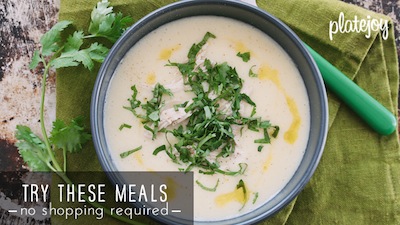As I cleaned out my camera this morning – apparently a year’s worth of food photos had eaten up all the space on my memory card, fancy that – I was transported to the Christmas tamale feast I shared with my family a year ago. Smells of roasted tomatoes and memories of creamy masa made my heart pump and my stomach grumble.
Since I am not able to partake in the festivities this year, I thought it only appropriate to revisit this wonderful two-part adventure of corn husking and rolling. So please, feast with your eyes and if you are so moved or inspired, try this slightly different take on holiday fare. These are recipes that are made with a lot of hands and a lot of love and the work that goes into each edible present is worth its weight in guacamole.
Enjoy and chow on.
Here we go, everyone. We are about to embark on a journey through the creation of homemade, low sodium, high-kicking tamales. A two-part adventure filled with mouth watering photos and step-by-step instructions will whisk you off to a world where fresh herbs, roasted tomatoes, and a juicy pork butt are transformed into a decadent celebration for your mouth.
For those of you who have never been privy to the fun of these little steamed presents, a tamale, or tamal, is a Latin American dish that traditionally consists of corn husks filled with masa, meat, cheese, chilies, salsa, and sometimes even half of a boiled egg or an olive.
There are many variations of the tamale and this holiday season we decided to venture beyond the comforts of convention and attempt four variations of the classic. My mother-in-law doled out a recipe to each of us from her new tamale book and the assignments were as follows:
- artichoke and sundried tomato tamales with olive oil and saffron
- fresh corn tamales with black truffle oil
- chicken tamales with BBQ masa
- and pork carnitas, or “little meats,” tamales with pineapple salsa
My mission was the pork carnitas tamales and, although the boy and I had best intentions to stick to the exact instructions of our recipe, a lack of ingredients at the market and dietary restrictions necessitated diversion from the rules. What’s new. I also forgot to mention that not only were the tamales low sodium, they were also pepper and chili free. That’s right, my mom cannot eat peppers or chilies.
No salt. No chilies. No peppers. No flavor? How on earth could these Mexican treats even taste good? Or more specifically, like it should? But with a little creative license, a hot broiler, and a whole bunch of garlic, we were able to create enough complexity in our flavors that no one was in need of anything but a napkin and some elastic wasted pants.
I will admit, I was a bit nervous before diving into this project. It seemed like it would be a lot of work with a lot of room for error. But it is a surprisingly simple recipe, and if you make the filling ahead of time and have a few extra hands on hand for the tamale construction, you can finish these quickly while having a great time.
So part one of our adventure will be the pork carnitas filling and part two (to hit inboxes across the nation next week) will focus on the pineapple salsa, the masa, and the assembling instructions to finish off the dish. Get out your note pad and pen and get ready to roll. Vamos a comer.
Low Sodium Pork Carnitas Tamale Filling
Ingredients:
- 4 tomatoes (or three tomatoes and two tomatillos if you can find them)
- 1 bunch of chives – you can use a knife to cut these or to make it even easier, use kitchen shears (i.e. scissors that live in your kitchen)
- 3 green onions, diced
- 1 small white onion, diced
- 6 cloves of garlic, diced
- 3/4 cup of no salt added ketchup (5mg per 1 tablespoon)
- zest and juice of 1 orange
- zest and juice of 1 lime
- 1½ pound of pork butt, cut into 1/2 inch cubes (69mg of sodium per 3oz)
- 1 teaspoon of olive oil
Directions
1. Turn your oven broiler on high and place the tomatoes (or tomato and tomatillos) in a pan on the highest rack so that they are directly under the flame. Watch them carefully; once they get a good char on their top side (about 3-5 minutes), flip the tomatoes over for another 3-5 minutes of direct flame action. Take them out of oven and let cool.
2. Turn off the broiler and heat oven to 350 degrees. Since your broiler was just on, your oven will reach the desired temperature faster than usual. This is a great trick for when you have to heat your oven quickly because guests are about to arrive or when that roast you have been cooking on low for two hours still is not done. It is a lifesaver in a time crunch.
3. In an oven safe dish (like a dutch oven or ceramic casserole with a top), combine your green onions, white onions, garlic, ketchup, lime juice, lime zest, orange juice, orange zest, and chives.
4. Dice the now roasted tomatoes (I did this directly in the pan with a fork and a knife – just be careful not to scratch the pan) and add them to your oven safe dish with all of the other aromatics. Mix well.
5. Add the cubed pork butt to the marinade (above). If you have time, let the pork sit in the liquid for a few hours to a day. The longer it marinates, the more intense the flavor infusion will be. But if you only have a few hours to get the tamales on the table, mix the pork well with the liquid and throw them into the oven.
6. Let the pork cook for 1.5 hours or until the meat pulls apart easily with a fork.
7. Heat a sauce pan over medium flame with the olive oil.
8. Fish out the cubes of pork (spider skimmers are awesome for this, but a slotted spoon or a strainer will be equally helpful) and sauté them in the oil for 5 minutes.
9. Add the leftover cooking liquid to the sauce pan and allow the mixture to reduce and thicken for another 15-20 minutes. And hi ho, your tamale filling is ready for packaging, eating, and enjoying.











Very nice recipe
Oh my gosh, I LOVE you. You are saving my Christmas traditions!